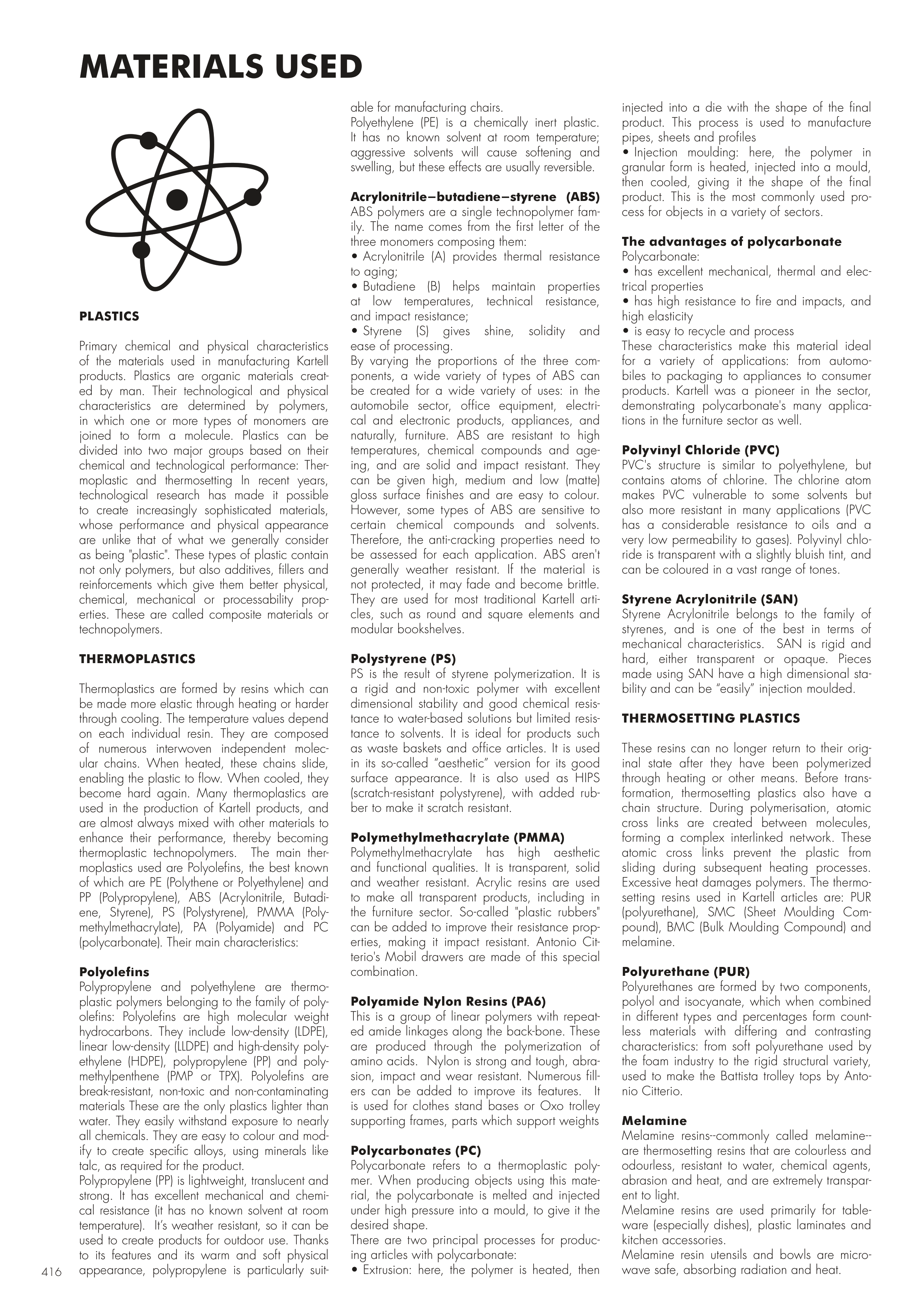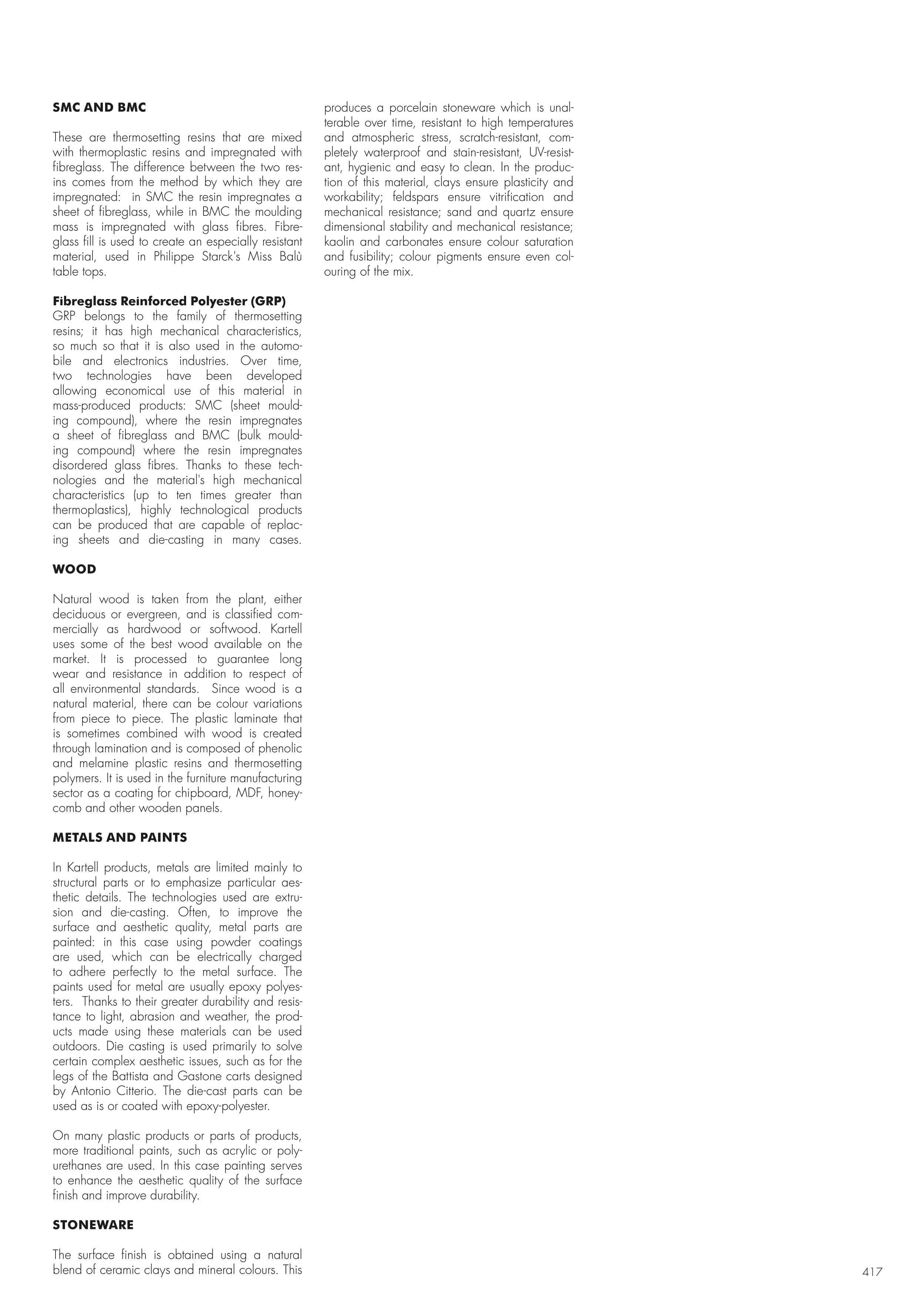416
PLASTICS
Primary chemical and physical characteristics
of the materials used in manufacturing Kartell
products. Plastics are organic materials creat-
ed by man. Their technological and physical
characteristics are determined by polymers,
in which one or more types of monomers are
joined to form a molecule. Plastics can be
divided into two major groups based on their
chemical and technological performance: Ther-
moplastic and thermosetting In recent years,
technological research has made it possible
to create increasingly sophisticated materials,
whose performance and physical appearance
are unlike that of what we generally consider
as being "plastic". These types of plastic contain
not only polymers, but also additives, fillers and
reinforcements which give them better physical,
chemical, mechanical or processability prop-
erties. These are called composite materials or
technopolymers.
THERMOPLASTICS
Thermoplastics are formed by resins which can
be made more elastic through heating or harder
through cooling. The temperature values depend
on each individual resin. They are composed
of numerous interwoven independent molec-
ular chains. When heated, these chains slide,
enabling the plastic to flow. When cooled, they
become hard again. Many thermoplastics are
used in the production of Kartell products, and
are almost always mixed with other materials to
enhance their performance, thereby becoming
thermoplastic technopolymers. The main ther-
moplastics used are Polyolefins, the best known
of which are PE (Polythene or Polyethylene) and
PP (Polypropylene), ABS (Acrylonitrile, Butadi-
ene, Styrene), PS (Polystyrene), PMMA (Poly-
methylmethacrylate), PA (Polyamide) and PC
(polycarbonate). Their main characteristics:
Polyolefins
Polypropylene and polyethylene are thermo-
plastic polymers belonging to the family of poly-
olefins: Polyolefins are high molecular weight
hydrocarbons. They include low-density (LDPE),
linear low-density (LLDPE) and high-density poly-
ethylene (HDPE), polypropylene (PP) and poly-
methylpenthene (PMP or TPX). Polyolefins are
break-resistant, non-toxic and non-contaminating
materials These are the only plastics lighter than
water. They easily withstand exposure to nearly
all chemicals. They are easy to colour and mod-
ify to create specific alloys, using minerals like
talc, as required for the product.
Polypropylene (PP) is lightweight, translucent and
strong. It has excellent mechanical and chemi-
cal resistance (it has no known solvent at room
temperature). It’s weather resistant, so it can be
used to create products for outdoor use. Thanks
to its features and its warm and soft physical
appearance, polypropylene is particularly suit-
able for manufacturing chairs.
Polyethylene (PE) is a chemically inert plastic.
It has no known solvent at room temperature;
aggressive solvents will cause softening and
swelling, but these effects are usually reversible.
Acrylonitrile-butadiene-styrene (ABS)
ABS polymers are a single technopolymer fam-
ily. The name comes from the first letter of the
three monomers composing them:
• Acrylonitrile (A) provides thermal resistance
to aging;
• Butadiene (B) helps maintain properties
at low temperatures, technical resistance,
and impact resistance;
• Styrene
(S)
gives
shine,
solidity
and
ease of processing.
By varying the proportions of the three com-
ponents, a wide variety of types of ABS can
be created for a wide variety of uses: in the
automobile sector, office equipment, electri-
cal and electronic products, appliances, and
naturally, furniture. ABS are resistant to high
temperatures, chemical compounds and age-
ing, and are solid and impact resistant. They
can be given high, medium and low (matte)
gloss surface finishes and are easy to colour.
However, some types of ABS are sensitive to
certain chemical compounds and solvents.
Therefore, the anti-cracking properties need to
be assessed for each application. ABS aren't
generally weather resistant. If the material is
not protected, it may fade and become brittle.
They are used for most traditional Kartell arti-
cles, such as round and square elements and
modular bookshelves.
Polystyrene (PS)
PS is the result of styrene polymerization. It is
a rigid and non-toxic polymer with excellent
dimensional stability and good chemical resis-
tance to water-based solutions but limited resis-
tance to solvents. It is ideal for products such
as waste baskets and office articles. It is used
in its so-called “aesthetic” version for its good
surface appearance. It is also used as HIPS
(scratch-resistant polystyrene), with added rub-
ber to make it scratch resistant.
Polymethylmethacrylate (PMMA)
Polymethylmethacrylate has high aesthetic
and functional qualities. It is transparent, solid
and weather resistant. Acrylic resins are used
to make all transparent products, including in
the furniture sector. So-called "plastic rubbers"
can be added to improve their resistance prop-
erties, making it impact resistant. Antonio Cit-
terio's Mobil drawers are made of this special
combination.
Polyamide Nylon Resins (PA6)
This is a group of linear polymers with repeat-
ed amide linkages along the back-bone. These
are produced through the polymerization of
amino acids. Nylon is strong and tough, abra-
sion, impact and wear resistant. Numerous fill-
ers can be added to improve its features. It
is used for clothes stand bases or Oxo trolley
supporting frames, parts which support weights
Polycarbonates (PC)
Polycarbonate refers to a thermoplastic poly-
mer. When producing objects using this mate-
rial, the polycarbonate is melted and injected
under high pressure into a mould, to give it the
desired shape.
There are two principal processes for produc-
ing articles with polycarbonate:
• Extrusion: here, the polymer is heated, then
injected into a die with the shape of the final
product. This process is used to manufacture
pipes, sheets and profiles
• Injection moulding: here, the polymer in
granular form is heated, injected into a mould,
then cooled, giving it the shape of the final
product. This is the most commonly used pro-
cess for objects in a variety of sectors.
The advantages of polycarbonate
Polycarbonate:
• has excellent mechanical, thermal and elec-
trical properties
• has high resistance to fire and impacts, and
high elasticity
• is easy to recycle and process
These characteristics make this material ideal
for a variety of applications: from automo-
biles to packaging to appliances to consumer
products. Kartell was a pioneer in the sector,
demonstrating polycarbonate's many applica-
tions in the furniture sector as well.
Polyvinyl Chloride (PVC)
PVC's structure is similar to polyethylene, but
contains atoms of chlorine. The chlorine atom
makes PVC vulnerable to some solvents but
also more resistant in many applications (PVC
has a considerable resistance to oils and a
very low permeability to gases). Polyvinyl chlo-
ride is transparent with a slightly bluish tint, and
can be coloured in a vast range of tones.
Styrene Acrylonitrile (SAN)
Styrene Acrylonitrile belongs to the family of
styrenes, and is one of the best in terms of
mechanical characteristics. SAN is rigid and
hard, either transparent or opaque. Pieces
made using SAN have a high dimensional sta-
bility and can be “easily” injection moulded.
THERMOSETTING PLASTICS
These resins can no longer return to their orig-
inal state after they have been polymerized
through heating or other means. Before trans-
formation, thermosetting plastics also have a
chain structure. During polymerisation, atomic
cross links are created between molecules,
forming a complex interlinked network. These
atomic cross links prevent the plastic from
sliding during subsequent heating processes.
Excessive heat damages polymers. The thermo-
setting resins used in Kartell articles are: PUR
(polyurethane), SMC (Sheet Moulding Com-
pound), BMC (Bulk Moulding Compound) and
melamine.
Polyurethane (PUR)
Polyurethanes are formed by two components,
polyol and isocyanate, which when combined
in different types and percentages form count-
less materials with differing and contrasting
characteristics: from soft polyurethane used by
the foam industry to the rigid structural variety,
used to make the Battista trolley tops by Anto-
nio Citterio.
Melamine
Melamine resins--commonly called melamine--
are thermosetting resins that are colourless and
odourless, resistant to water, chemical agents,
abrasion and heat, and are extremely transpar-
ent to light.
Melamine resins are used primarily for table-
ware (especially dishes), plastic laminates and
kitchen accessories.
Melamine resin utensils and bowls are micro-
wave safe, absorbing radiation and heat.
MATERIALS USED



